Do-it-yourself parquet laying: foundation preparation rules and work technology
No matter how developers of innovative floor coverings try to improve the material, the eyes of the rational owner of residential property invariably turn to parquet and massive classics. Despite the enormous number of advanced achievements in this area, the question of how to do competent parquet laying with your own hands is still relevant. After all, home craftsmen who are eager to lay an amazing patterned floor of wooden planks on their own have hardly yet translated.
Content
The main secrets of laying parquet
Parquet flooring is a complex structure consisting of one or more underlying layers and a top covering composed of wooden dies. Dies are also referred to as trims, parquet or rivets. They are represented by wooden elements of a predominantly rectangular configuration in plan, face and profile. Along the perimeter, the dies are equipped with grooves and ridges for fastening.
The observed component of the parquet floor
The width of the riveting planks is usually a multiple of the length, due to which various geometric ornaments are created without problems. The standards for the width of parquet floors are 5-7.5 cm, lengths 21-49 cm according to GOST, numbered 862.1-85. The thicknesses indicated in the data sheets start from 14 mm and end with 22 mm.
Note. The optimal thickness of the parquet floor for the arrangement of residential premises is considered to be 15-18 mm. Thinner strips quickly erase the working layer, especially if scraping is often done. Thick parquet floors are not elastic.
The material for the device of the parquet floor can be supplied not only in the form of rectangular planks. There are ready-made panels with parquet floor fragments gathered on a coniferous base and modules fastened on top according to the principle of ceramic mosaic with cardboard or paper.
Hidden to the eye base
The number and technical characteristics of the underlying elements depend on the type and condition of the draft base, which is most often referred to as:
- concrete floors: prefabricated or monolithic floors with or without screed;
- wooden beams with lags installed for laying the flooring;
- a wooden floor, the floorboards of which, after repair and grinding, perform the function of a rough foundation.
According to the instructions of SNiP with number 3.04.01-87, rivets or finished parquet boards are allowed to be laid on a prepared basis. Within 2 meters of the completed preparation, deviations in height of not more than 2 mm can be recorded. Those. when installing a 2-meter rail on the subfloor in an arbitrary vector direction max, the clearance between this control device and the surface can be only 2 mm, preferably less. The slope is acceptable, but its size is limited by the same directory: max 0.2%, not exceeding 5 cm.
The primary goal of a stand-alone paver is to form a rough foundation that meets the technical requirements. The number and type of future operations determines the material from which the rough basis is made, and the degree of wear.
The challenges of using moisture resistant plywood
The second stage, the result of which is to be admired and boasted, consists in the piecewise laying of elements on a prepared basis. According to the overwhelming majority of technological schemes, the upper layer of preparation is a moisture-resistant plywood substrate, because it:
- serves as a reliable module for attaching small-caliber dies-rivets of the parquet floor;
- compensates for the difference in thermal expansion of the concrete base and the coating of wood;
- excludes leakage from the ceiling and from the moisture subfloor, which can render expensive natural material unusable;
- performs the function of a shut-off element in the case of a floating floor device;
- plays the role of a leveling layer.
If it is possible or necessary to reduce the height of the ceilings by 5 cm or more, you can trivially purchase sets of adjustable floors with the Knauf brand and conduct training, both on concrete and wood, in one day. Products of the same manufacturer should be used if dry alignment with expanded clay as a heater to be held over a cold basement.
So, we found out that plywood should be used. There are plenty of ways to level it. For a while, we will forget about the existence of factory kits for dry screed and analyze budget options for preparation, which will require inexpensive building materials and our own resources.
Three training options
The quality of the alignment carried out before the installation of the parquet floor affects the number of finishing operations and the service life of the coating. Those who want to lay their own flooring securely and aesthetically in their own hands should know that due to defects in the base:
- they will become shaky, cracked, and after a very short period of time, the crests of the parquet will break;
- the floor will creak mercilessly;
- will have to carry out additional grinding, thinning the working layer of the material. As a result, the number of scrapings-polishes required for the subsequent restoration of the parquet floor is reduced.
In order to avoid such unsightly consequences, we will consider how the alignment of the three types of base is made under the parquet.
Screed fill conditions and patterns
The screed is poured mainly to eliminate defects in concrete floors:
- Differences in height and defects within 1-2 cm are removed by grinding the concrete floor with the subsequent pouring of either cement-sand or polymer leveling mortar. Before screeding, the base is primed twice with a penetrating compound. A two-component polyurethane primer stabilizes and strengthens the upper layers of the subfloor and will perform the function of waterproofing.
- With defects of more than 2 cm, re-pouring of the leveling layer with the laying of polyethylene as a waterproofing and a cutting layer will be required. From strips of polyethylene, you need to build a kind of pallet with 10 centimeter sides. Because the thickness of the layer is usually 3-4 cm, they are used for leveling mainly sand-cement mixtures with reinforcement. Reinforcing is more economical and more convenient with polypropylene fiber, but it is also possible with a mesh.
Fill the layer of cement-sand leveling under the parquet should be at least 4 weeks. According to rounded popular estimates, 1 week is given for hardening 1 cm of screed. At the end of the specified period, laying should also not be rushed if the dies are to be fixed directly to the leveling layer. You need to wait more than 5-6, even better 7 weeks, until the moisture ceases to stand out from the screed.
Attention. If it is planned to glue parquet floors directly to the primed screed, cement mortars with M150-300 grades must be used to fill it. They are characterized by high compressive strength. Parquetin glue will need elastic.
It is not necessary to wait for complete hardening if moisture-proof plywood is laid on top of the fill.28 days are enough, and it can be fixed with self-tapping screws or dowel-nails to the leveled floor. Sheets of plywood are cut for this into 4 parts and stacked with a run according to the principle of brickwork. Cut to minimize expansion and eliminate wavelike swings. Between the quartered segments there are 2-3 mm gaps for linear compression-expansion. The metal hats are recessed by 3-5 mm in plywood so as not to damage the grinding disc later.
Attention. If, in addition to self-tapping screws, glue is also used to fix plywood sheets to the screed, it is recommended to purchase it with the same brand and properties as the primer to optimize adhesion.
When applying glue, the process of laying parquet on a plywood substrate will need to be postponed. You will have to wait for the curing period specified by the manufacturer of the binder. After that, the plywood preparation is ground along the seams, in order to remove differences in the height of adjacent sheets, as well as pollution and factory flaws.
A technological gap of 0.9 - 1.2 cm must be left between the walls and the plywood layer around the perimeter. It is formed with the help of expansion wedges. Spacers do not clean until they have completely laid parquet flooring. Only at the end of the installation they need to be removed, the gap created by the wedges should be filled with mounting foam so that moisture does not get on the side faces in the future. On top of the foamed seam close the baseboard.
Attention. The baseboard is attached only to the walls, its slats do not fit tightly with the parquet. At least 1 mm must remain between the parquet and the baseboard.
Logs as a way to align
He is the method of dry screed, which allows not to stretch the process of flooring for many months due to long technological interruptions. For construction plywood lag systems use a beam with sides 4 and 5 cm. Work is carried out according to the following algorithm:
- Logs are installed after 30 cm, fixed with screws or corners to a concrete or wooden draft base. Between the ends of the beam and the walls, you need to leave a traditional gap for linear expansion.
- It is leveled in a horizontal plane by adding sand, if the rough foundation is made of concrete, by lining wedges, ruberoid or parchment inserts, if the base is made of wood. Surplus is cut with a planer.
- In plywood cut into 4 equal parts, 9 holes are pre-bored, through which they are fastened to the logs with self-tapping screws. The brick laying principle is respected by default, as well as the perimeter deformation indent. No cross-docking is allowed.
- By analogy, a second layer of plywood substrate is constructed. Only the quartered sheets are laid with an offset so that the seams of the first row do not coincide with the seams of the second. The first layer of plywood is treated with a primer, then glue. Then screws are twisted, the size of which depends on the total thickness of the plywood layer.
- After the glue dries, grinding is performed.
The plywood substrate on the logs is laid in two layers, the total height of which should approximately be equal to 30 mm. The thickness of the plywood laid on the screed is determined by the thickness of the parquet. Usually it is less than the equivalent parquet size by 5 mm.
Boardwalk preparation
It consists in repair and polishing of floorboards, if their thickness after processing by the grinding unit does not become less than 30 mm. In the opposite case, the boards will have to be dismantled and new material laid on top of which the parquet strips will be mounted.
If the board replaces the first layer of plywood corny, its thickness in total with the thickness of the substrate can not exceed 3 cm. And you can lay it with centimeter gaps to ensure ventilation and temperature movement.
Note. It is advisable to choose an adhesive primer for wooden floors with antistatic properties.
Technological procedure for laying parquet
There are a lot of options for laying dies at the disposal of parquet floorers: from the simplest “deck” with a herringbone to complex art drawings with mosaic modules and borders. In anticipation of the work, a layout plan is being drawn up, which can be guided along any of the walls or at a 45º angle. Corner installation is advised to start from the center row. You should do the same if you cannot get solid rows of the selected pattern.
To orient the first row, they build something like a mooring cord. Two nails are hammered into plywood from opposite sides of the row planned for laying, and a fishing line is pulled on them.
It is not forbidden to apply one-component glue, but it is better to spend money and buy a two-component. He certainly will not give off harmful water for the parquet.
In principle, the technology of laying parquet is quite simple, it consists in the sequential implementation of the following actions:
- the prepared surface is carefully covered with soil;
- with a spatula-comb, glue is applied to a small area, because dries the binder extremely quickly;
- a pre-assembled fragment of two or three dies is laid on the adhesive, taking into account the mooring point. Parquet floors are glued with some effort. Extra glue squeezed out from under the parquet should immediately be removed;
- You can attach each installed plank with two or three nails or studs through the comb. Hammer the hardware at an angle of 45º. The nail caps should be drowned in the crest with a parquet chipper. Parquetin can be fixed through three elements;
- fully laid parquet is left for the period of glue curing;
- then they grind it in two or more steps, changing sanding paper at each stage to an analog with smaller grain sizes. Grind until the defects that appear during operation are cut off;
- open stain, if you want to change the color of the floor, then varnish in 3-9 layers.
Parquet floor construction technology has a lot of wisdom. However, there is nothing beyond complexity. Of course, the first laid parquet is unlikely to be similar to the floors in Versailles, but it's worth a try. Suddenly come out better?

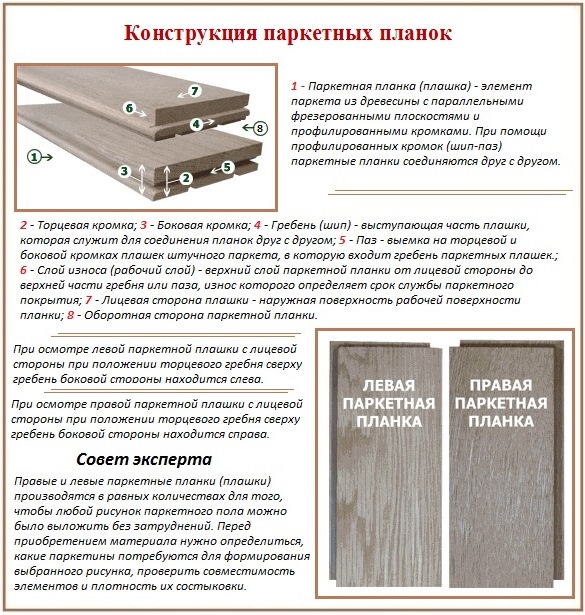
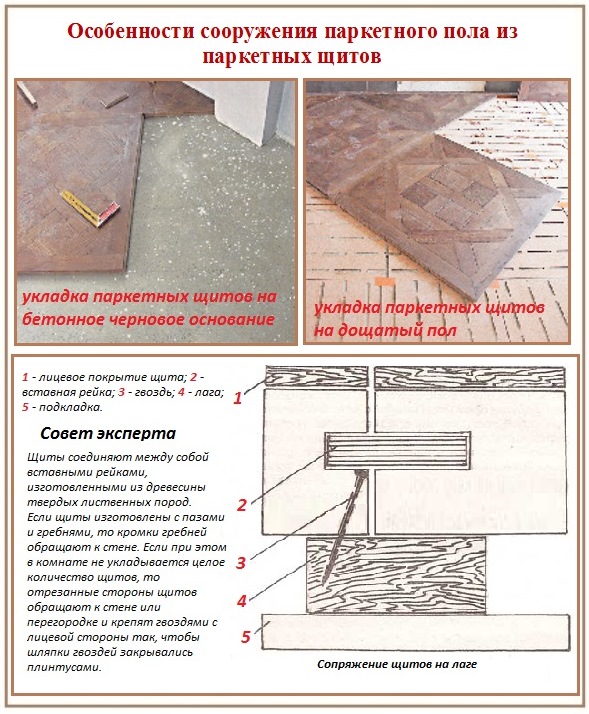
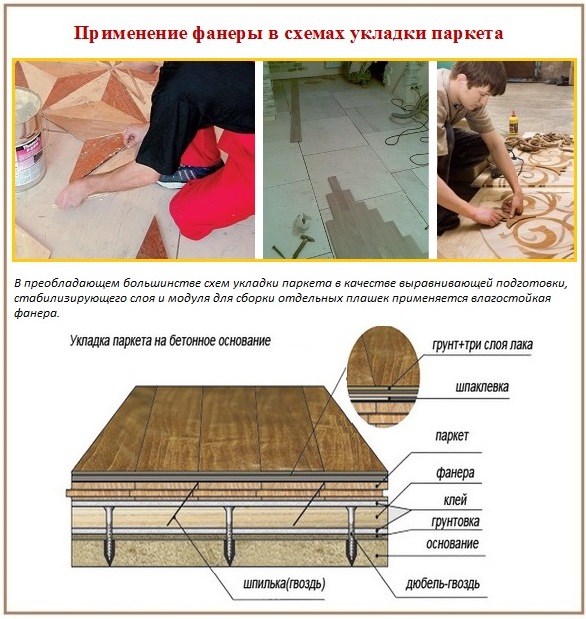
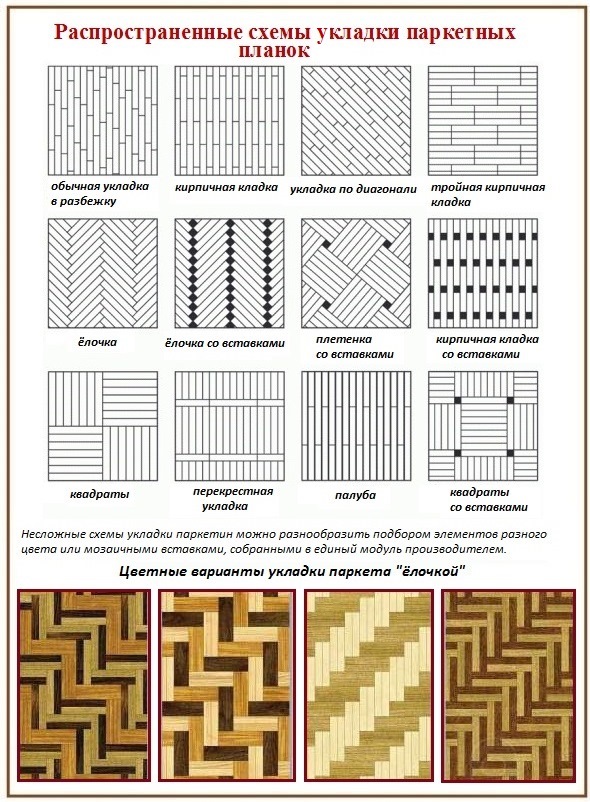
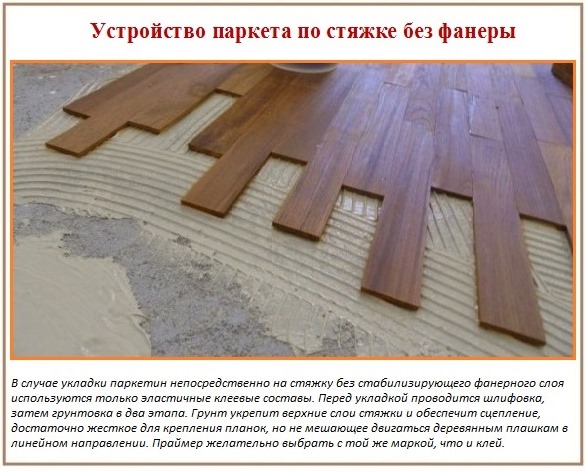

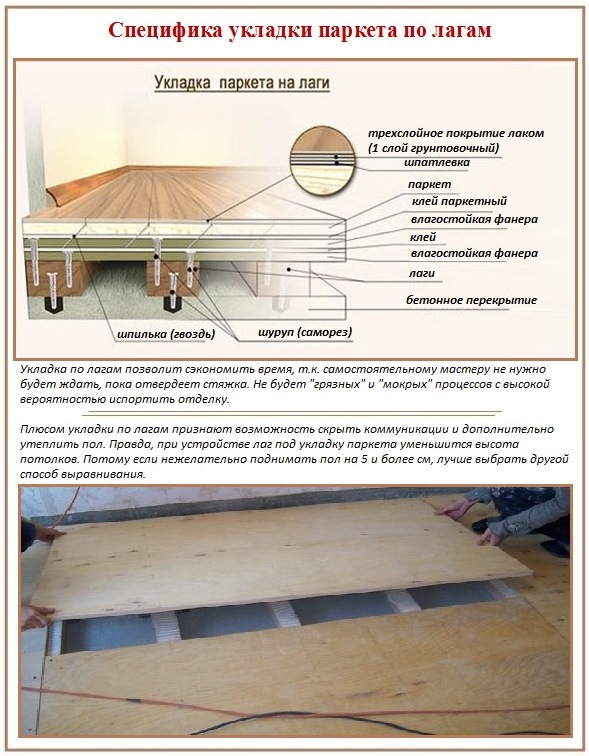

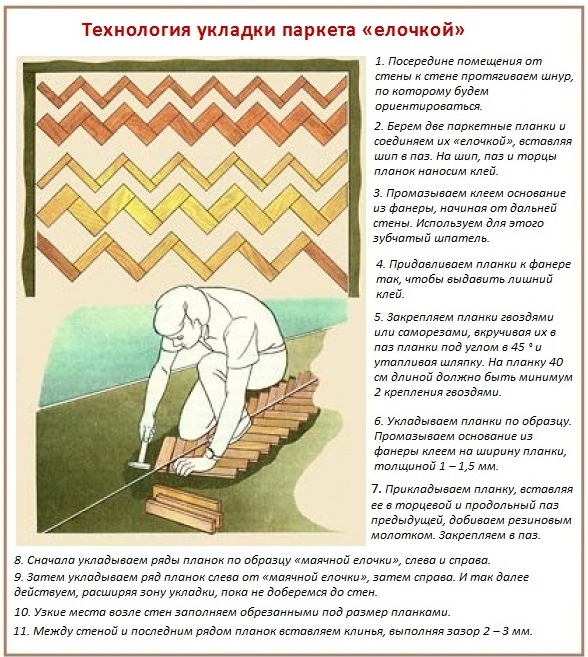
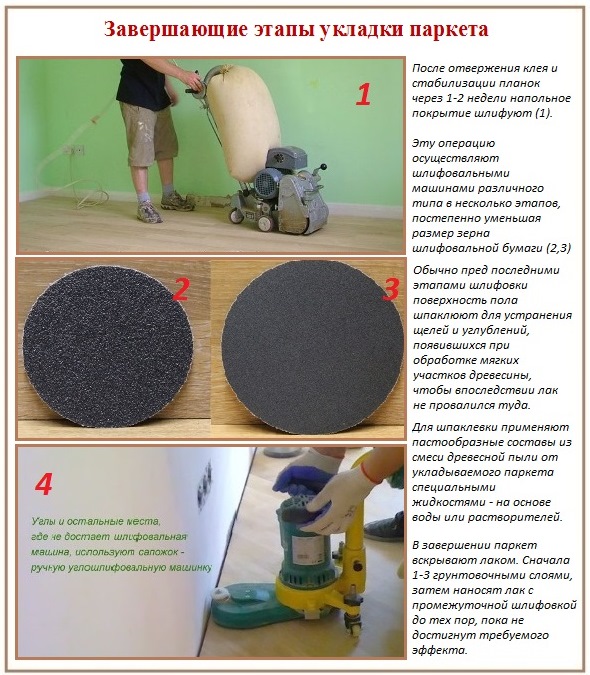
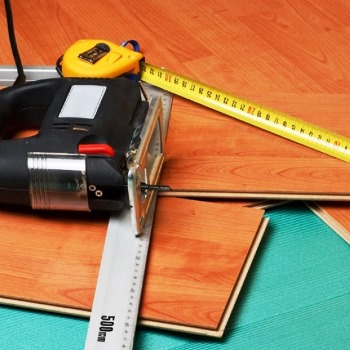
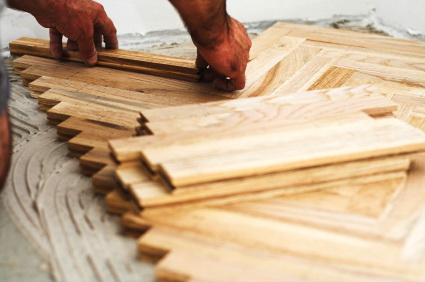
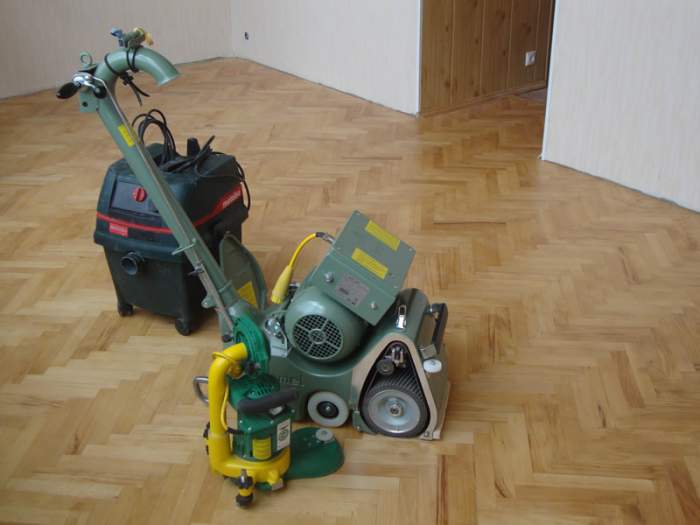
13 comments